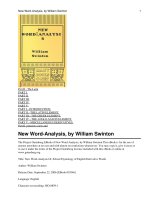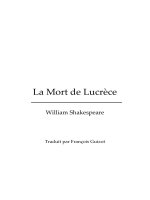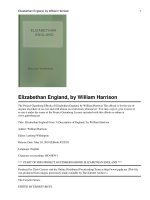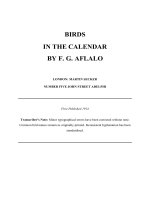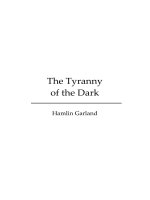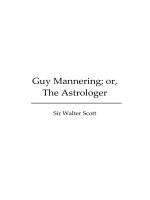The daffodils by william wordsworth analysis essay
Bạn đang xem bản rút gọn của tài liệu. Xem và tải ngay bản đầy đủ của tài liệu tại đây (43.46 KB, 4 trang )
“The Daffodils by William Wordsworth”
The poem “The Daffodils” (1804) was written by William Wordsworth – one of the
most typical writers during the English Romantic Movement, especially among people
living in the Lake District. Since he was the representative of a school of poetry of
English Romanticism, W. Wordsworth was influenced by the pessimistic writing style
which can be observed throughout his lifelong works. “The Daffodils” was inspired when
W. Wordsworth and his beloved sister Dorothy were strolling through the “long belt” of
beautiful golden daffodils near Ullswater Lake in England. William said from the very
first lines of the poem “I wandered lonely as a Cloud”, although being accompanied by
Dorothy. The poet through his work recalled the breath-taking scene of the union of
ordinary gay daffodils living vividly in his memory to help him to overcome the pensive
mood, which embraced the sentimental symphony between the human and nature and
brought about the thought of the power of imagination to enjoy the “bliss of solitude”.
W. Wordsworth in “The Daffodils” had shown his skillful way in creating a short
lyric poem to transmit his ideas and emotion. This lyric poem consists of four stanzas;
each stanza consists of six lines. Each line of the poem is metered in an iambic tetrameter.
The rhyme scheme “ABABCC” was followed in the poem which expressed naturally
emotion. The lyric poem was a very typical and traditional style for English poetry;
furthermore, it is also one of his best lyric poems in modern times. The poem was
subjective because it expressed the feeling of the poet himself; one of the key
characteristics of Romanticism.
As he loved nature, so the main theme of the poetry is the beauty of nature. The
poem was a beautiful scene of a golden daffodil field making the explorer overcome in
front of its beauty. The use of poetry in figurative language made it much more attractive
to readers. In the poem "The Daffodils," W. Wordsworth mentioned a scene he had
articulated and had the chance to look at the valley, which was full of large quantities of
daffodils. He was a nature lover, and such a scene was intriguing to him. He used
beautiful imagery to describe the scene. There was the loneliness of feeling in his mind,
though, even as he walks alongside a lake with a fascinating scene. With the term
"crowd" for a large number of daffodils, he calls himself a host. He personified the
flowers and enables them to dance and the word "flutter" like the butterflies do.
It also allowed him to create the magical effect of elegance in the words he used,
with two characters emerging in comparison. W. Wordsworth, as a nature lover, the
daffodils are idealized as a friend. His state of mind during a walk as a “lonely cloud”,
began with a lonely free adventure. They sound hopeless and pressing. Then those
daffodils are described with a melancholic mood, using a metaphor depicted light and
bright life by ‘wandering’, ‘dancing’, ‘glee’. He was instantly cheered, joyful, and
dreamy as he saw a 'crowd' of golden daffodils free fluttering. The stanza's general
emotion was generated by the last two lines. It's all a fantasy. Furthermore, at the start of
stanza 2, the poet uses simile to equate flowers to stars and a crowd of flowers to a galaxy
of stars. Later, while sitting on his couch in a vacant or pensive state, the sight of the
daffodils flashes through his mind, transforming his mood and filling his heart with joy
and pleasure. To dance along with the daffodils. Thus, when the poet felt sad, gloomy, the
thought of the daffodils fills his heart with happiness, pleasure. William used various
literary devices, and it was through these figures that we were able to get a greater
understanding of the vivid image he paints and the way he connected with nature.
After the stroll to the “long belt” of daffodils, the wanderer, whenever experienced
loneliness, recalled the happy daffodils. The daffodils had become his everlasting
memory, which could heal his empty heart. The impression was that he has an 'inward
eye' allowed him to feel at one with the world and its natural beauty, and not lonely while
he was alone. The mind and spirit of the poet were forever engraved with the memory of
the daffodils. The author also used stylistic techniques such as the oxymoron "the bliss of
silence" which illustrated some of the advantages of being alone, and the inversion "and
then my heart with pleasure fills" which described the mechanism and character of
"filling the heart". Flowers seemed to be blooming everywhere in front of him. So, his
loneliness and sadness vanished, and he decided to dance with the daffodils.
“The Daffodils” lets us imagine the sum of appreciation and respect William has for
nature. He wanted to inspire us to return to nature and enjoy it. Furthermore, William
could persuade us that what we feel when we see golden daffodils was the way they
connect with us with their spirit. Daffodils grow into something more than just flowers.
They were a sign of natural beauty and, most importantly, of living a life full of
experiences and sensations that make life worthwhile. They reflect the pleasure and
happiness of leading an adoring and rewarding life, enjoying it with every drop of nectar
it can offer, in their light-hearted dance. Daffodils, on the other hand, have had a
profound influence on my soul.
Word count: 913
References:
“I Wandered Lonely as a Cloud.” Wikipedia, Wikimedia Foundation,
/>LitCharts. “I Wandered Lonely as a Cloud Summary & Analysis by William
Wordsworth.” LitCharts, www.litcharts.com/poetry/william-wordsworth/iwandered-lonely-as-a-cloud.
